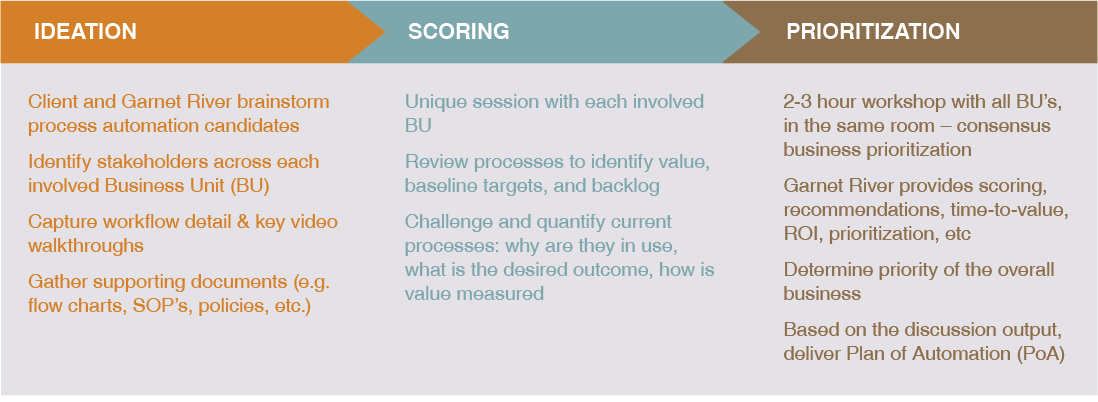Process assessment is the driver of successful RPA implementation
Most organizations have an ideas for automation candidate but struggle with defining value. Process assessment can help answer this question and get you started.
Reading time: 2 minutes

At its core, robotic process automation (RPA) provides simple, easy to develop software solutions to automate the human actions needed to interact with a computer to complete a job—or “process.” Its main goals are to:
- Free up capacity
- Reduce costs
- Improve the value and quality of completed tasks
Most organizations recognize the value of RPA, with 90 percent of large organizations saying they will adopt RPA in some form The typical flow of the patient revenue cycle can be divided into three sections: Patient Access, Care to Claim, and Claim to Payment. In each of these sections, Robotic Process Automation (RPA) can add value by executing repeatable process traditionally carried out by a human worker. The result: improved efficiency, greater accuracy, reduced cost, and higher employee satisfaction.
PROCESS ASSESSMENT LIMITS COSTS, MINIMIZES DISRUPTION
At Garnet River, we offer a free QuickStart Process Assessment as part of our delivery vehicle. It identifies RPA opportunities that are easy and quick to implement…while offering tangible savings and benefits.
The following represents our path:

Having such a well-defined approach allows for the identification of a Proof of Concept (PoC). A good PoC process is small in scope and involves only one business unit. The objective is to implement RPA with minimal effort and limited cost to show how quick (within 6 weeks) and effective (ROI within 6-9 months) RPA can be. Garnet QuickStart provides this, as well as a PoA that allows for the scaling and implementation of automations that have been identified as drivers of organizational performance.
MEASURABLE IMPACTS KEY PRIORITIZATION
Most organizations have a lot of ideas for automation candidates, but many never ask this basic question: what is the real business value of automating the process?
Not understanding the real business value of automating a process will prevent successful RPA engagement. The automation may work, but the cost to implement—both disruption to employees and dollars invested—will outweigh the benefits. The result will be disengagement from RPA as a driver of business outcomes…and lost opportunity to meaningfully optimize processes for profit.
Process assessment ensures the right tasks are targeted for automation. At minimum, the following questions should be asked:
- Can we automate this process?
- Should we automate this process?
- What will we gain by automating this process?
This is where measurable impacts come in.

The identified measurable impacts above provide the framework for answering the questions that need to be asked when selecting RPA targets.
In a way, process assessment is like the result you get after entering an address into your GPS and selecting the route from the options presented. It’s a tool that taps into available data to map your journey. There are different routes, but the best is the route that meets your objectives…and in the case of RPA implementations, the more they align with your business priorities, the more successful your automation experience will be.
About Garnet River
Founded in 2000 and based in Saratoga Springs, N.Y., Garnet River provides comprehensive and flexible staffing and staff augmentation services, innovative robotic process automation (RPA), and managed outsource solutions to public- and private-sector clients. Garnet River is a partner with UiPath, Microsoft, Cisco Meraki, Hewlett Packard Enterprise, and others. For more information, visit garnetriver.com.


